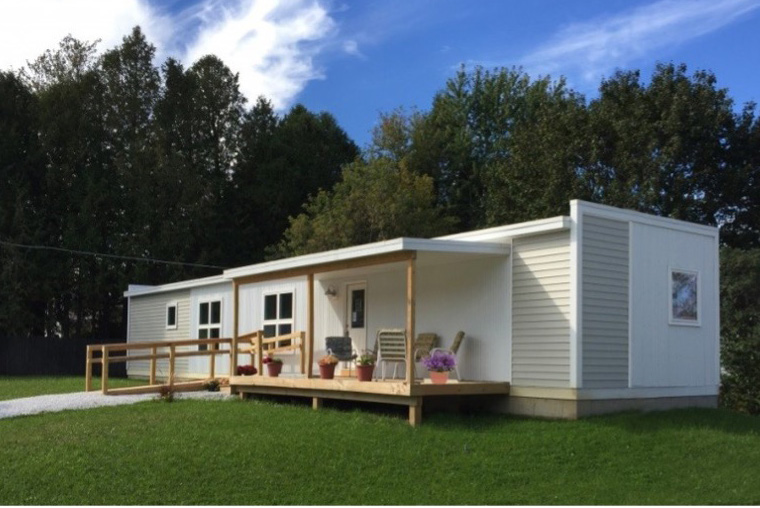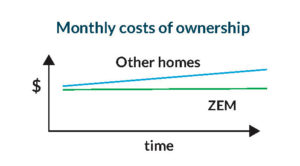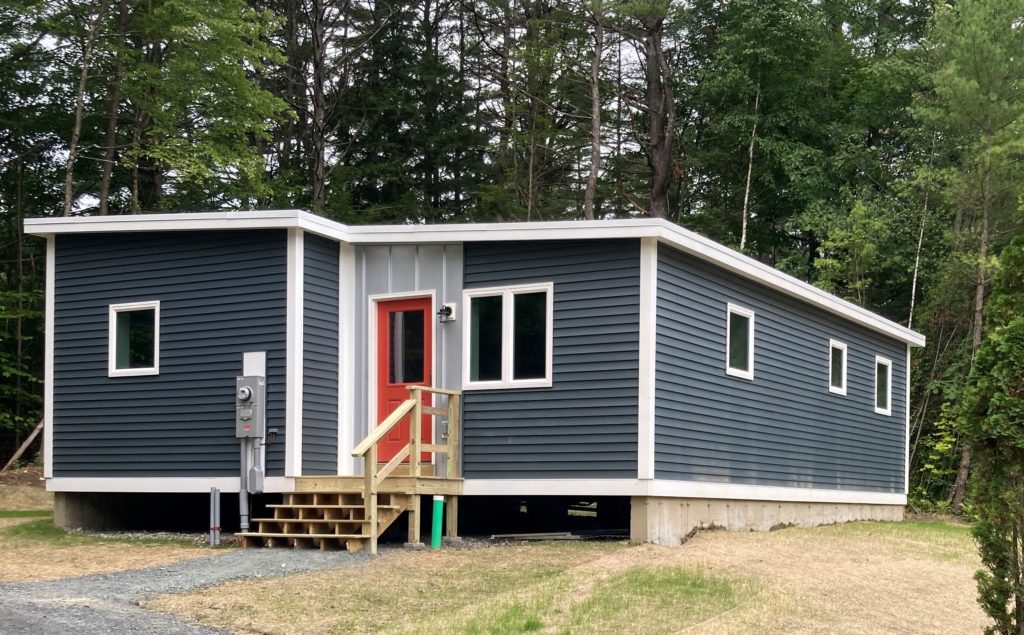
EXECUTIVE SUMMARY
The BlueGreen Alliance Foundation’s (BGAF) Building Clean program is an initiative to strengthen domestic manufacturing by accelerating energy-efficient retrofits for affordable multi-family housing. As part of this initiative, BGAF has completed a product database with information on American manufacturing sites that produce healthy energy and water-efficient products.
The Buy Local, Buy Healthy database, accessible through www.buildingclean.org, provides material supply chain information for manufacturers, residents, building owners, and contractors to learn about energy efficient housing products and hazardous materials. For the next step in BGAF’s work on accelerating retrofits, we are highlighting successful programs across the country that incentivize buying local or buying healthy.
The Zero Energy Modular (ZEM) program works to place low-to-moderate-income families into modular homes that are durable, efficient, affordable, and healthy. By using high-quality materials that reduce off-gassing and an in-home CERV ventilation system to track CO2 and VOC levels, the ZEM Program is a model example of the buy healthy concept.
BACKGROUND: EFFICIENCY VERMONT
Efficiency Vermont is an energy efficiency utility that provides Vermont residents with technical services and financial support, including rebates for energy-efficient products and information on DIY weatherization. They are run by the Vermont Energy Investment Corporation, a non-profit working with utilities, governments, and businesses to tackle energy efficiency, climate change, renewables, and energy equity.
The ZEM Program began in 2013 when Efficiency Vermont and the Vermont Housing and Conservation Board undertook a combined effort to address the gap in housing available to low-and moderate-income homebuyers. With an initial goal to provide housing options that were durable and resilient, they partnered with VerMod to begin constructing zero-energy modular homes.
Since 2013, the ZEM Program has built over 110 homes in 11 counties across Vermont and 8 homes out-of-state in New Hampshire and Massachusetts. These homes produce as much energy as they consume, utilize materials with fewer toxicants, are outfitted with ENERGY STAR appliances, are designed for harsh weather conditions, and use a CERV ventilation system that monitors and adjusts the indoor air quality.
By emphasizing the importance of healthier materials and using a ventilation system that maintains VOC and CO2 levels below 1000 parts per million (ppm), combined with resident education and assistance, the ZEM Program produces a safe, efficient, and affordable home that allows residents to save energy and live healthier lives.
Efficiency Vermont Impact in 2019:
27.9% of Vermont households served.
Reduced electric costs from 9 cents/kwh to 4 cents/kwh.
$2 saved for every $1 invested.
12 million metric tons of pollutants saved between 2000-2019, equivalent to all Vermont car use over four years.

WHY DO HEALTHIER MATERIALS MATTER?
Building product choices matter when talking about indoor health. These choices are even more significant for low-income families because of their particular vulnerability to environmentally derived diseases. The use of healthier and greener materials has been shown to reduce exposures to toxic chemicals that can harm health. Respiratory issues, asthma, and lead poisoning can be avoided by using low-VOC paints, sealants, and finishes to reduce off-gassing, maintaining fresh air ventilation, installing insulation without flame retardants, and using low-to/no-formaldehyde materials.
ZEM HOMES AND HEALTH
The Zero Energy Modular homes produced through this program address health in three ways:
- Healthier material selection
- High-efficiency HVAC
- Mental health impacts
Efficiency Vermont and VerMod work to address the health impacts of housing materials on residents. They select GreenGuard certified bamboo floors, no-VOC primers and paints, low-VOC adhesive for countertops, and fiberglass insulation, materials shown to have little or no negative effects on human health.
Efficiency Vermont and VerMod contracted with Build Equinox, an Illinois-based company that created and manufactures the CERV fresh air ventilation system. The CERV unit came on the market in 2013, in conjunction with the start of the ZEM Program. In a ZEM home, the resident is able to choose the parts per million (ppm) levels of VOCs and CO2 that they prefer to be maintained. The CERV system works by constantly monitoring and measuring those levels and bringing in fresh air whenever the VOCs or CO2 levels rise above the ppm setting the resident chooses. It also recirculates the air within the home to remove particulate matter and works with the heat pumps installed in the unit to exchange energy between ingoing and outgoing streams.
Because the CERV is a relatively new and complicated system, Efficiency Vermont and VerMod work closely with the homeowner to educate them on its use. VerMod ensures that the residents have helpful resources and can get answers related to the CERV unit at any time.
Because the ZEM units produced by this program are safe, durable, healthy, comfortable, and (relatively) low maintenance, ZEM units circumvent many of the stresses low-income and elderly residents face in their homes. Phoebe Howe from Efficiency Vermont emphasized that in her experience, health issues tend to be the dominant concern for the potential residents she meets. The ZEM homes help to mitigate these concerns and improve overall mental health of the residents.
ZEM Units

The ZEM units were created by VerMod in an attempt to provide quality housing that low- to moderate-income prospective homebuyers could afford. They pioneered zero energy affordability from standardization of every home from the beginning of the program.7
ZEM units include the following energy-efficiency measures:
- High levels of insulation
- Detailed air sealing
- Triple-paned windows
- Tier 3 ENERGY STAR appliances
- LED lighting
- Grid-tied photovoltaic (PV) solar cells
- CERV ventilation
- Heat pump water heater
- Air-source heat pump
The ZEM homes come with all appliances, including a stove, dishwasher, washer/dryer, and HVAC. Efficiency Vermont offers a multitude of rebates and incentives for Energy Star products, as well as an incentive for low-income homebuyers of around $7,000. Both Efficiency Vermont and VerMod work
closely with prospective homebuyers throughout and after the process.
While ZEM homes benefit from significantly lower operational costs, their durability and high-performance construction make them more expensive than standard mobile homes. To ensure these homes are affordable and accessible, eligible applicants can benefit from income-based grants, subsidies, and low-interest loan programs. For those seeking VerMod homes as mobile home replacements, Champlain Housing Trust provides a Manufactured Housing Down Payment Loan to people with incomes under 120% of area median income. This is a $35,000 loan that can be used to cover the house’s down payment and is repaid with no interest upon sale or refinancing of the home. Buyers with an area median income of under 120% are eligible for shared equity grants through the Vermont Housing and Conservation Board, which subsidizes the cost of buying a house through grants up to $50,000 or 20% of the home’s price.
In the short term, homeowners save money with no energy costs. They avoid maintenance expenses over the long term and repairs common in other mobile units, all while saving money and reducing stress.
Program Impacts
Tracking health outcomes in housing can be difficult. The current method of resident self-reporting has to contend with issues of bias or confusion. However, in 2016, Efficiency Vermont partnered with the University of Vermont to assess the homeowners that lived in a ZEM unit for at least a year. The study found that 81% of residents surveyed said their air quality felt improved compared to their previous home and 56% noted they were having an easier time breathing.
From 2013-2019, the Zero Energy Modular Homes have also:
- Saved $1,156,875 in energy costs for owners (heat & electric)
- Average 675ppm CO2 and 802ppm VOC levels (healthy levels are below 1000ppm)
- Avoided 2,214 metric tons of CO2 emissions

CONCLUSION
Keys to Success
In completing this case study, the BlueGreen Alliance Foundation noted the following steps taken that led to successful program implementation and longevity.
Local partner collaboration is essential.
The ZEM program is a result of the collaboration and coordination of multiple groups working within Vermont affordable housing: The Vermont Investment Corporation, Efficiency Vermont,VerMod, Build Equinox, and the Vermont Housing and Conservation Board. Each of these partners plays a specific role in ensuring the program runs smoothly.
With Build Equinox and VerMod, it was also important that the people in charge shared and cared about the vision of the program: addressing the gap in quality, affordable mobile housing for low-to-moderate-income residents.
